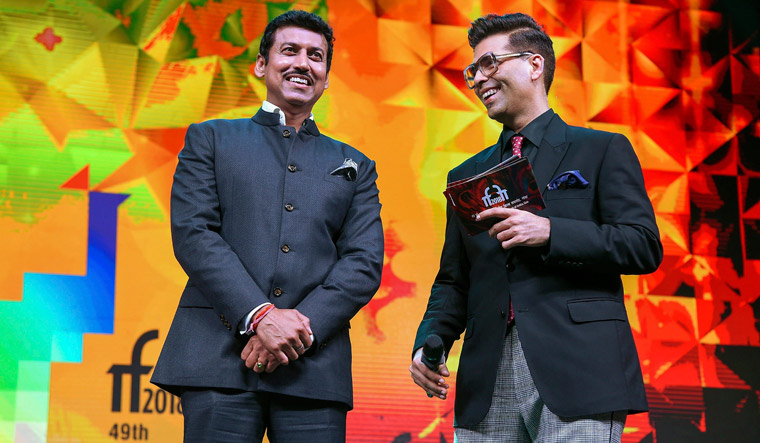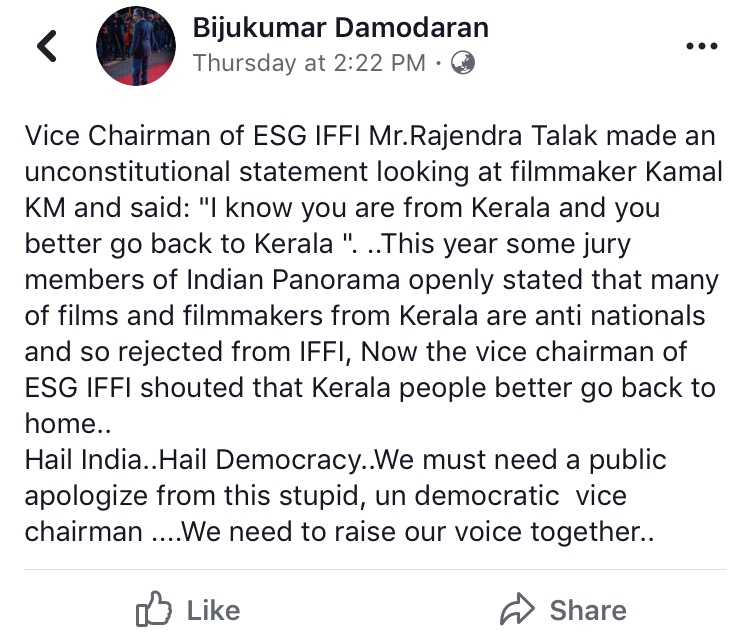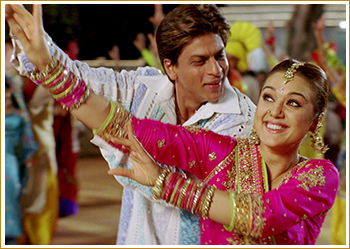 Image Courtesy: The Week
Image Courtesy: The Week
In an interview, director Ujjwal Chatterjee, one of the officials in charge of selecting films for screening at the 49th International Film Festival of India (IFFI), said that six or seven films were rejected from the festival because they were deemed “anti-national”. The IFFI was held in Goa between November 20 and 28 this year.
He said, “We have no problems with criticism but no film should hurt the sentiments of a certain section of people. Even if a film has to give importance to a personal view, things have to be seen from the national perspective. One can’t express anti-India sentiments, derogatory words against the country or even encourage an attack against a particular religion. There were at least six-seven films that wrongly represented India. They were not considered because they reflected anti-national sentiments.”
The director also said that to be selected for the “Indian Panorama” section, a film had to be “culturally and visually in sync with what India represents.”
Films for the Panorama Section were shortlisted by a 13-member jury headed by director and screenwriter Rahul Rawail.
The Indian Panorama section has always been one of the most sought-after features of the IFFI. As the term suggests, the section is meant to showcase the multiplicity of voices in Indian cinema. But in recent years, disturbing trends have emerged in the festival’s film selection process that has put the veracity of the term at stake. I investigate three major points of exclusion of the festival.
Anti-National Films
This year the festival showcases 26 feature films and 21 non-feature films, with Shaji Karun’s Malayalam film Olu inaugurating the feature film segment of the Indian Panorama.
What’s disturbing, however, is that for the first time in recent years, no Kannada film figures in the section. Paddayi, a Tulu language film, directed by Abhay Simha is the sole representative from Karnataka.
In the same report published by The Hindu, Kannada filmmakers like T.S. Nagabharana, N.R. Nanjunde Gowda and others have expressed displeasure at this exclusion and attributed it to the interference of the Ministry for Information and Broadcasting in film festivals. Prakash P. Shetty, the producer of the acclaimed Ammachiyemba Nenapu, has even called out the “politics” of the act.
Furthermore, on 22 November (at 2:22 PM), National Award-winning director of Malayalam films and screenwriter Bijukumar Damodaran wrote a Facebook post, calling out derogatory remarks made by a senior official at IFFI who echoed the same bias against Malayalam cinema seen in Ujjwal Chatterjee’s interview.

The post read: “Vice Chairman of ESG IFFI Mr Rajendra Talak made an unconstitutional statement looking at filmmaker Kamal KM and said: “I know you are from Kerala and you better go back to Kerala “…This year some jury members of Indian Panorama openly stated that many of films and filmmakers from Kerala are anti-nationals and so rejected from IFFI, Now the vice chairman of ESG IFFI shouted that Kerala people better go back to home.. Hail India..Hail Democracy. We must need a public to apologize from this stupid, undemocratic vice chairman… We need to raise our voice together..”
Ujjwal Chatterjee had mentioned in the interview that there were “45 entries in Malayalam. Most were related to the Naxalite movement. Some films were outright rejected because they were anti-national!”
To understand the “politics” of this act, I spoke to Dr Karen Gabriel, Associate Professor and Head of the English Department at St. Stephen’s College, and author of Melodrama and the Nation: Sexual Economies of Bombay Cinema, 1970-2000. “The use of this clause in today’s time is directly in line with the right-wingers in the country,” she explained, “and dates back to the history of the relationship between cinema and sedition, right from the colonial times.”
“In colonial India, the British identified the film industry as a seditious medium. This was so because it was the first time that cinema had aligned itself with the swadeshi struggle, and the presence of symbols like the charkha or the tricolour flag had become common sights in the movies. Alarmed by the evocative power that films wielded, the British introduced a system of media control,” said Dr Karen Gabriel.
Its main pillars were the Dramatic Performances Act 1876, Newspaper (Incitement to Offences) Act 1908 and Indian Press Act 1910. Cinema too joined the list, and the Indian Cinematograph Act 1918 evolved out of this. It had two main functions – (i) licensing of cinema theatres and (ii) censoring of films.1 To safeguard the public from indecent or offensive films, securing a license from the local civil authorities became mandatory. This not only gave immense statutory powers to the officials to decide a film’s destiny but also paved the way for compulsory pre-censorship of each and every film. The objectionable practices prohibited under the guidelines included – extenuation of crime, glorification of criminals and vicious characters, contempt against the institution of marriage, the exhibition of nudity, character assassination, disrespect to foreign nations, fermenting social unrest and spreading disaffection or resistance to government.2
Post-independence one would expect the leaders of the world’s largest democracy to discontinue the colonial legacy of film censorship, but to everyone’s dismay, not only was film censorship in India retained, in fact, a centralized body, known as the Central Board of Film Censors (CBFC), was set up to ensure absolute authority of the central government on matters of film exhibition. Consequently, amendments to the Cinematograph Act of 1918 were made to include sections for censorship.
“The use of this clause in today’s time is directly in line with the right-wingers in the country,” Dr Gabriel continues. “If a film, or art, is in line with the idea of state nationalism, it is allowed, but if a film goes against this idea then it is called an anti-national film, and banned in the best interests of the nation-state.”
This isn’t the first time the IFFI has propagated this peculiar kind of “nationalism”. In 2017, The Wire had reported, the national anthem played 37 times each day during the festival. The IFFI had also got embroiled in a controversy after the film S Durga was chosen for screening in the same “Indian Panorama” category and then suddenly dropped from the line-up by. The director of S Durga, Sanal Kumar Sasidharan, when contacted expresses a sentiment of indignation, “A confident and prosperous state should not fear its own artists and look at them suspiciously always. If any kind of criticism of the state of affairs is branded as anti-national and turned down, then it shows that the government wants to hide its inabilities. It is very sad and discouraging for an artist to go through this discrimination,” he says. Last year, six jury members had then written to the ministry asking it to reconsider, and filmmaker Sujoy Ghosh had even resigned from the jury in protest. In a personal chat with a few other filmmakers who did not wish to be named, I was told that despite their films winning awards at other festivals in the country, they had refrained from even submitting their films to the IFFI being fully aware that they would be excluded. It this nothing but an example of this limited imagination of nationalism that a film like Padmaavat is chosen while Manto is not. (Another case in point could be Anand Patwardhan’s latest documentary, Reason which did not make it to the IFFI or even MAMI this year, but went on to win the Best Feature Documentary at the IDFA, possibly the largest documentary film festival in the world.)
Thus, I asked Dr Gabriel, what it was about the term “Indian Panorama” itself that evoked anxiety amongst officials?
“The heterogeneity of India has always been a source of anxiety for the state,” she explained. “And one of the fundamental reasons for this anxiety is that this is not a coherent nation but a composite of a number of states given a singular nationality. The national arena is limited to where the power lies. Correspondingly the idea of what remains as the centre and what gets relegated to the margins takes formation. The default centre of the discourse has always been the North of India, largely the cow-belt, but more specifically the region around Delhi and the Hindi belt. Even when the Hindi film industry is situated in Mumbai, the centre still remains to be the North. So, these North Indian habits, be it food habits like butter chicken or bhangra etc. are homogenised and imposed.”
 Image Courtesy: MadanMohan
Image Courtesy: MadanMohan
The use of film, particularly, Hindi films, to solidify a national identity has been a recurrent move under the regime. A few years ago, nine “militant” organisations from North-eastern states like Assam and Manipur had banned theatres from screening Hindi cinema citing the invasion of hybrid Indian culture through Bollywood Hindi films as “the immediate and dangerous threat to our socio-cultural values, and ultimately to our national life.” Another example of the link between Hindu nationalism and cultural promotion of Hindi language was the forcible telecast of Hindi films and shows in prime-time television in Tamil Nadu. It was only after the political leaders protested against it that the move was overturned.
Thus, this anxiety of heterogeneity comes from a very limited imagination of the nation, that has no tolerance for local idioms, and therefore it is not surprising to see that no Kannada film was selected. Calling the Indian Panorama Section, “a fiasco”, Dr Gabriel called out the festival’s “the over-representation of Hindi cinema and the under-representation of every other region.”
Bringing Brand Israel to Bollywood
Israel is the country in focus at the International Film Festival of India (IFFI) this year. Ten Israeli films, including The Other Story, were screened at the IFFI in collaboration with the Consulate General of Israel in Mumbai. Veteran Israeli filmmaker Dan Wolman was given the Lifetime Achievement Award this year.
In her article, Bringing Brand Israel to Bollywood, Apoorva G writes about “Bollywood Shalom”, a special event for the Indian film industry establishment, organized by Israeli Prime Minister Benjamin Netanyahu during his visit to India in 2017. The event was held in Mumbai where Bollywood stars like Amitabh Bachchan, Karan Johar, Ronnie Screwwaala were in attendance.
““Throughout his visit, Netanyahu and the Israeli delegation made it clear that they are trying to push the “anti-terror cooperation” narrative onto Indian-Israeli relations. In his address at the Hyderabad House in New Delhi, Netanyahu said: “Indians and Israelis know too well the pain of terrorist attacks. We remember the horrific savagery in Mumbai.” It did not come as a surprise then that the venue chosen for the Bollywood Shalom was the Taj Hotel, which in 2008 was the city of a major terror attack,” read the report.
“Actions likes these made clear,” says Apoorva, “that Israel is intent on having Bollywood help sell “Brand Israel” and assist in its cynical use of arts and culture to whitewash its settler-colonialist regime, occupation and apartheid over the Palestinian people and lands.”
At a time when acclaimed international artists like Lauryn Hill, Ken Loach, Mira Nair, and singer-songwriter Lorde, among others, are resisting association with Israel, this celebration of Israel as the country in focus is an alarming move of visible propagandist strides.
#MeToo
The Indian film industry is replete with testimonies of gender-based assault and harassment against those in positions of power. These testimonies, in the face of hostility, disbelief and fear of recrimination, are making visible the entrenched and long ignored patriarchal power structures of the film industry.
In the last month, two big film festivals addressed the #MeToo in admirable ways. “Calling the #MeToo “a profound collective reckoning”, the Mumbai Academy of Moving Image (MAMI) dropped three films, AIB’s Chintu Ka Birthday, Rajat Kapoor’s Kadakh, and Ere Gowda’s Balekampa from the line-up of the 20th edition of the film festival. Sessions and workshops were organised by the festival team to address sexual harassment at the workplace sensitively.
The Dharamshala Film Festival too organized a panel discussion, “MeToo and Independent Cinema” on October 1 this year, where filmmaker Anamika Haksar, film critic Trisha Gupta, and editor Bina Paul discussed appropriate responses to the testimonies of sexual abuse.
In a sharp contrast to such avowal, the opening film for the world premiere at the IFFI was Julien Landais’ The Aspen Papers, the cast of which includes Jonathan Rhys Meyer and Morgane Polanski, the daughter of Roman Polanski, a child rapist and fugitive from the U.S. 1978, U.S. who fled the country while awaiting sentencing in his sexual abuse case. IFFI is a government enterprise, but we see absolutely no conversation on the issue. In fact, some of the accused are there in full attendance. Barring a token representation panel where filmmakers Meghna Gulzar, Leena Yadav and Gauri Shinde discuss women directors in Indian cinema, there is no cognizance of the historical gravity of the movement.
These exclusions reveal that markers of progress or development must not be restricted to matters or economy or science but extend themselves equally to forms of art as an organ of the social body. They also usurp the claims that the Hindi film industry is a “melting point of cultures and an example of India’s secularism. Cinema is neither politically innocent nor does it convey an unequivocal secularism3.
1. Source: Chapter 3. “Censorship Regulations”. http://shodhganga.inflibnet.ac.in/bitstream/10603/186551/7/08_chapter%203.pdf.pdf
2. Same as above.
3. Deshpande Anirudh. “Indian Cinema and the Bourgeois Nation State”. Economic and Political Weekly, Vol. 42, No. 50 (Dec. 15 – 21, 2007), pp. 95-101, 103.
Read More
The Importance of Art in Hard Times
Sui Dhaaga: Weaving Deception
“Time for polyphony” : Jerry Pinto on the Task of a Translator




